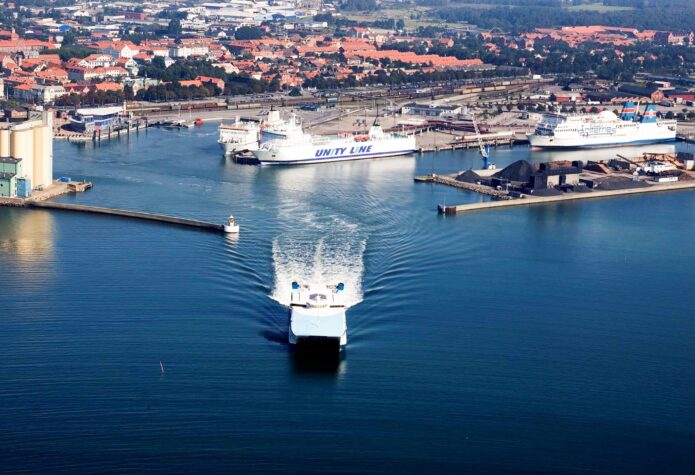Port of Ystad – where the Nordics meet Central Europe

Each year, up to 1 billion tons of cargo and 50 million passengers travel through the Baltic Sea, making it one of the world’s busiest maritime regions. The Port of Ystad on Sweden’s Baltic coast is now expanding its infrastructure to strengthen one of Europe’s most important transport connections.
The Port of Ystad in Southern Sweden plays an important role in the county’s trade, infrastructure and tourism, as it connects the Nordics to the growing markets of Central and Eastern Europe through Świnoujście in Poland.
In 2017, the port saw a new record turnover of 3.6 million tons of goods, including some bulk as timber, coke, pellets and grain. The municipality of Ystad is relatively small with around 30,000 inhabitants, but its location and port have turned it into a transport hub.
“We had over 2.2 million passengers travelling through Ystad last year, which makes us the third largest ferry passenger port in Sweden”, says Karin Persdotter, EU Strategist at the Port of Ystad. “The port is the fastest connection for ferry traffic to Poland and the Danish island of Bornholm, with further connections from Bornholm to Copenhagen.”
While trade and passenger volumes are increasing, reports by Interreg Europe state that the number of ships navigating through the Baltic Sea has decreased. This highlights a trend towards larger vessels.
“The ports in the region have to prepare for larger ships and provide access and appropriate infrastructure for loading and unloading to keep up with industrial developments”, says Ms Persdotter.
Expanding European connections
Co-financed by a loan from NIB, the Port of Ystad is now expanding its infrastructure southwards to cater to larger ships. Two new berths will be constructed, and the break-water on the south side will be enlarged. After the expansion is completed in 2021, the inner port area will continue to be used for ferry traffic and conventional vessels.

“The ports in the region have to prepare for larger ships and provide access and appropriate infrastructure for loading and unloading to keep up with industrial developments.”
Karin Persdotter, EU Strategist at the Port of Ystad
“We are also planning to expand the hinterland infrastructure, including the road connections that are currently still creating bottlenecks in traffic flows”, adds Ms Persdotter.
The Port of Ystad has been identified as a “comprehensive port” in the EU’s TEN-T network, and is an important extension of the Baltic-Adriatic transport corridor. Now, Ystad aims to become a “core port” in the network by 2023.
“Improving the port infrastructure for ferry services and commercial shipping between Sweden and Poland will not only have an impact on the Baltic-Adriatic corridor, but also on other crucial transport corridors, such as the nearby Scandinavian-Mediterranean corridor and the Orient-East Med corridor.”
The future of maritime transport and travel
It is estimated that commercial shipping and passenger ferries account for approximately 3-4% of carbon emissions caused by man. The pollution is mainly the result of exhaust pollutants generated by ships using heavy-fuel oil or marine diesel oil.
Despite its great potential, shipping hasn’t been prioritized in any of the international agreements coordinated through the Paris Agreement on climate change. However, in a bid to become greener, the Port of Ystad has built a High Voltage Shore Connection plant to supply power to ships at berth.
“Ships can plug into the port and tap into the local power, instead of idling and burning fuel just to lie still”, explains Ms Persdotter. “In addition, the port’s own vehicles already run on hydrogenated vegetable oils or electricity, and future plans to invest in solar panels to supply the lighting system are in the works.”
New vessels are designed to carry more without a proportional increase in fuel use. This way, freight and passenger transport are becoming more efficient, and in the short term, efficiency gains are going to be the greatest contribution to greenhouse gas reduction.
“To provide efficient and sustainable transport infrastructure, cooperation between national governments and across regions is crucial. The loan from NIB has further supported the port expansion by providing an additional review of the project, which has ensured its financial readiness”, says Ms Persdotter.

